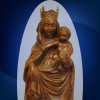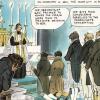NACMS has classified our publications by level to aid you in finding material most helpful to you:
- Basic for those new to the Marianist world and having little or no prior knowledge of Marianist history or the Marianist charism
- Intermediate for those who have some knowledge and understanding of things Marianist
- Advanced for those who have significant knowledge and understanding of things Marianist and want to go deeper
- Resource materials, including prayers, activities, and reflections for individuals and groups
- Reference materials, including source documents and compendia
The resources listed below are found within our e-publications and bookstore. Items available in our library are not listed, but can be found by searching in our library catalog.
From Exile to Mission: Fr. Chaminade's Defining MomentAfter many turbulent years amidst the French Revolution that included the government’s suppression of faith and the exile of priests who would not profess their loyalty to the government, Blessed William Joseph Chaminade was exiled from France and went to Saragossa, Spain. There, he encountered the Shrine of Our Lady of the Pillar. |
||
The Witness of the First Lay Marianist ConsecrationBro. Tim Phillips, SM offers this reflection on the first Lay Marianist consecration on February 2, 1801, which marked the beginning of the Marianist Family. |
||
Podcast: Inspiration in Exile - Carol RameyIn this episode of Sharing Our Marianist Stories, Carol Ramey, former NACMS director and a sought-after presenter on Marianist topics, reflects on Father Chaminade’s exile in Saragossa, Spain. |
||
Community Meeting Kit: A Spectacle of Saints“A Spectacle of Saints” explores the Marianist candidates on the path to sainthood and how we are blessed with ordinary saints in our lives today. |
||
Opening New Doors to Our Knowledge of Blessed Father ChaminadeBrother Tom Redmond, SM, traces the origins of the conflicting time periods for Chaminade’s founding inspiration for the Society of Mary. Was it 1787 or 1797? The result of Brother Tom’s analysis is a “new door,” a deeper understanding, into the Marian dimension of the Marianist charism. |
||
Community Meeting Kit: Praying with Faith of the Heart"Faith of the Heart" was one of William Joseph Chaminade's essential teachings. Marianists today, therefore, regard this as an essential part of Marianist life. But what is "Faith of the Heart," and how can we enact it in our lives? |
||
Marianist Heritage Virtual Tour VideosIn January of 2023, to honor Marianist Heritage Month, NACMS created eight virtual tours of significant locations in Marianist History. |
||
Marianist Heritage Sites Photo AlbumA collection of photos of foundational sites for the Marianist Family, along with detailed descriptions of the photos and locations. |
||
Podcast: "We are All Missionaries:" Reading Chaminade's Letter of 1839In this episode, Patti Gehred and Sr. Gabby Bibeau discuss the most famous and most important letter in Marianist history: Father Chaminade's Letter to the Retreat Masters of 1839. In this letter, Chaminade lays out exactly what it means to be Marianist, especially the importance of Mary and her power to defeat evil, as well as our call to be missionaries. You don't want to miss this one! |
||
Podcast: Beatification Memories (Interviews Commemorating the 20th Anniversary of Chaminade's Beatification)On September 3rd, 2000, Father Chaminade was Beatified along with five other holy people during a Mass in St. Peter's Square. Pope St. John Paul II was the presider, and he noted that Blessed Chaminade was an "apostle of the laity." In this podcast, we interviewed six different people who were at the Beatification and the events surrounding it. Each of them provides their own perspective on that experience, as well as the legacy of Chaminade officially being named "Blessed." |






